In 1922, William Webb arrived in South Australia from the United States of America to be Chief Commissioner of the state government’s railway system. Four years later, three classes of powerful locomotives, based on plans provided by the American Locomotive Company, Schenectady, NY, were delivered from Sir W.G. Armstrong Whitworth, Newcastle upon Tyne, England. Made to slightly modified United States designs, the locomotives were of a size previously unimagined in the quiet backwater that was South Australia, or anywhere else in Australia.
These radically more powerful locomotives were to fulfil Webb’s determination to increase the railways’ financial performance by reducing gross ton-miles and increasing net ton-miles of trains. He also increased full carload lots and introduced large freight cars, heavy track, stronger bridges and efficient management and operational practices.
Webb’s rehabilitation of the decrepit South Australian Railways was achieved at great cost to the South Australian treasury, and was accompanied by political turmoil. However, the advances that he introduced in all aspects of railway operations set a new standard that inspired railway administrators in other Australian states, enabling, among other things, the huge achievements of the Australian railway systems during the Second World War. After Webb returned to the United States in 1930, South Australian locomotive and rolling stock design and construction continued to be state-of-the-art for another quarter of a century.
Three locomotive classes were delivered in 1926 as follows, with ten in each class:
- the 500 class: a 4-8-2 locomotive having 51,000 pounds of tractive effort – for heavy haulage of passenger and freight traffic on heavy lines
- the 600 class: a 4-6-2 locomotive having larger driving wheels and 39,300 pounds of tractive effort – for fast haulage of passenger traffic
- the 700 class: a 2-8-2 locomotive having smaller driving wheels and 40,400 pounds of tractive effort – for freight traffic on lighter lines.
Soon after delivery, all three classes had their springing modified and their lateral wheel movement increased to enable them to routinely negotiate the tight curves often found on the system, particularly in the Adelaide Hills. After these modifications the locomotives were considered outstanding successes.
The 500 class (‘Mountain’ type wheel arrangement, 4-8-2; later modified to ‘Northern’, 4-8-4)
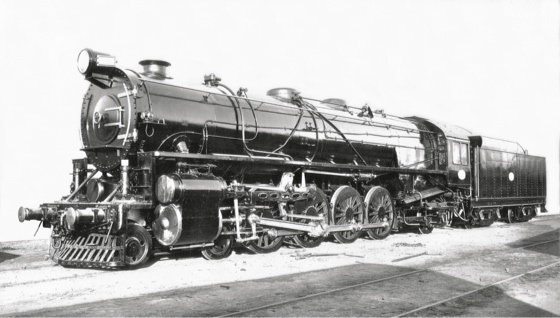
A 500 class loco as delivered. At this stage, it had a two-wheel trailing truck before a booster was fitted, and buffers with screw-link couplers in addition to automatic couplers. It was not until the mid-1930s that automatic couplers were used exclusively; buffers were removed in the late 1940s. [South Australian Railways photograph; copyright expired.]
The line over the Mount Lofty ranges immediately east of Adelaide included a 19-mile (31 km) continuous 1-in-45 (2.2%) gradient, for which three Rx class (4-6-0) locomotives were needed to lift the heavy Melbourne Express. For this route especially, a powerful locomotive design was needed. The 500 class was rated to haul 500 tons when it was introduced; the Rx had been able to haul only 190 tons. When delivered, they were the most powerful locomotives in Australia.
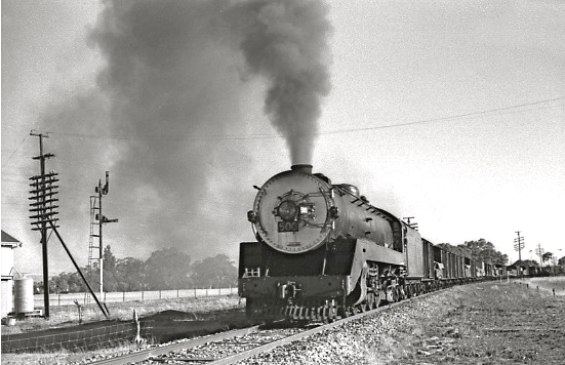
Class leader 500 charged northwards with a freight to Port Pirie after leaving Salisbury, January 1960. Photo © Donald R. McLean 1960.
Essentially the 500 class followed the United States Railroad Administration (USRA) Light Mikado design. The USRA had been formed in 1917 as a wartime emergency measure to overcome the more serious shortcomings of US railroads; Webb had been recruited to a senior post in the Administration in 1918. In its three-year existence the USRA had ordered almost 2,000 steam locomotives, all of them to modern, standardised designs. US railroads and locomotive manufacturers built many variants.
A diagram of the USRA Light Mikado is here.
There was a significant barrier to the South Australian Railways acquiring such locomotives. A policy of “Empire preference”, favouring goods manufactured in the British Empire, prohibited their purchase from a US company. But other designs submitted in response to the 1923 request for tender were more expensive and most were not a good response to the specifications. A solution was found in having the British company, Sir W.G. Armstrong Whitworth & Co. Ltd, build them to drawings initially prepared by a tendering company, the American Locomotive Company (Alco), of Schenectady, New York. Webb’s brilliant young engineer, Fred Shea, then travelled to Britain and worked with the engineering design staff at the Armstrong, Whitworth works. Shea and the firm’s engineers undertook the detailed engineering work necessary to translate the designs into practice. The many parts that could not be fabricated were imported to Britain from the US for inclusion in assembly.
Following their delivery in 1926 there was a series of teething troubles, but thereafter they were an outstanding success.
The main differences in appearance between the USRA Light Mikado and the SAR 500 class were that the 500 class pilot truck had four wheels rather than two (to reduce the axle load in view of the light rail found in South Australia); the boiler and cab roof were lowered about 300 mm (12 inches) to fit into the lower South Australian Railways loading gauge; and the 500 class boiler was several feet longer than the USRA version. The driving wheel diameter was 63 inches (1600 mm) in both types and the wheelbase almost identical. The USRA loco delivered 54,720 pounds of tractive effort; the 500 class 51,000 pounds.
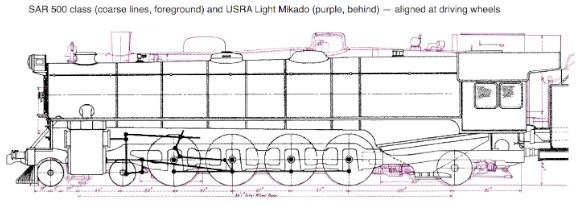
SAR 500 class superimposed on USRA light mikado (in purple), showing the similarity in dimensions. In particular, the spacing and diameter of the wheels on the two types are almost identical.
New four-wheel trailing trucks were progressively fitted in place of the two-wheel trucks starting in 1929, three years after the 4-8-4 wheel arrangement was introduced in the US. The new trucks incorporated booster mechanisms (supplementary two-cylinder engine mechanisms that could be engaged at low speeds, when the power output of the loco was at its lowest). A booster increased the starting tractive effort from 51,000 pounds at 85% boiler pressure to 59,000 pounds; the extra pair of wheels avoided the weight of the booster mechanism adding to the axle loading. The load capacity over the Mount Lofty ranges increased to 600 tons. Locos with boosters were reclassified “500B”. Although locos of the 4-8-4 wheel arrangement would more correctly have taken on another name, most likely ‘Northerns’, such had been the publicity surrounding their arrival that the name ‘Mountains’ stuck in the minds of the public and railway employees alike.
Other Australian railways were influenced by Webb and his practices. In relation to locomotives, the D57 class (4-8-2) locomotives of the New South Wales Railways Department, built in Australia three years later, were highly derivative of the SAR 500 class (however, the D57 needed three cylinders, since the somewhat narrower NSW loading gauge precluded cylinders of the size permitted within the SAR’s loading gauge); and the Victorian Railways X class (2-8-2) locomotive of 1929 was also influenced by these designs.
The 600 class (‘Pacific’ type wheel arrangement, 4-6-2)
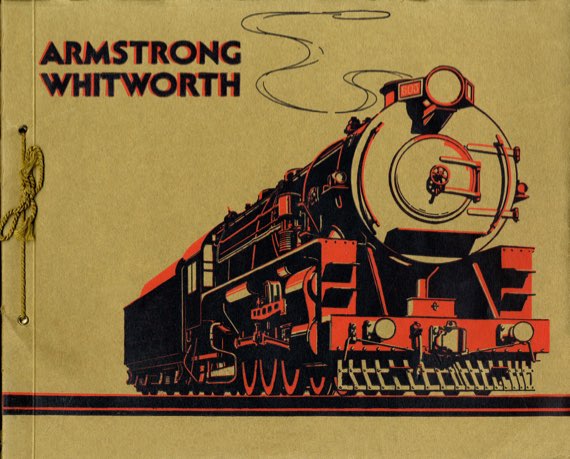
The South Australian Railways 600 class Pacific featured on the cover of the Armstrong Whitworth catalogue in the 1920s (by Armstrong Whitworth [public domain], via Wikimedia Commons)
The 600 class fulfilled Webb and Shea’s requirements for fast haulage of heavy passenger trains. Their tractive effort was 39,300 pounds, almost double the 21,200 pounds of the existing Rx class (4-6-0) workhorses. The new locomotives’ 75 inch (1905 mm) diameter driving wheels made for speed (the second-largest driving wheels in Australia, the largest having been the 78 inches (1981 mm) wheels of the SAR’s 1894 vintage S class 4-4-0 -- a fast but somewhat slippery locomotive with a tractive effort of 12,900 pounds.
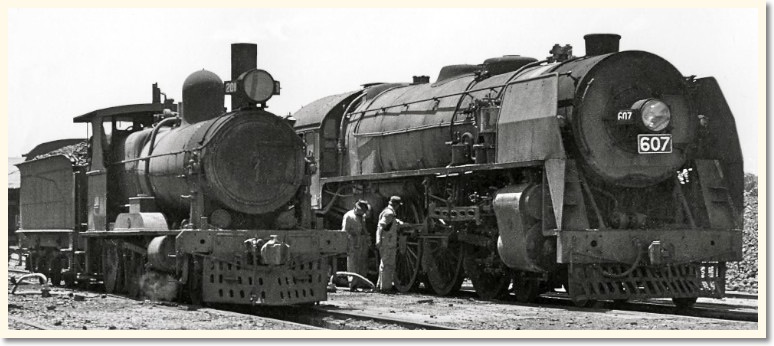
This 1952 photograph shows, on the right, one of Webb’s 600 class (4-6-2) locomotives. Its 75 inch (1905 mm) diameter driving wheels and almost 40,000 pounds of tractive effort made it ideal for high-speed haulage of passenger trains. On the left is the ubiquitous 1909 vintage Rx class (4-6-0) locomotive, which until 1926 was South Australia’s most powerful type, with a tractive effort of just over half that of the 600 class. [Lionel E. Bates photo.]
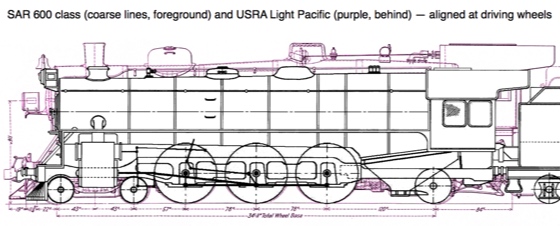
The foreground image in this diagram is a general outline of the 600 class (South Australian Railways, 1926). In the background is part of a general arrangement diagram of the USRA Light Pacific locomotive (from Locomotive Cyclopedia of American Practice, 1922; public domain). The spacing and diameter of the wheels on the two types are almost identical.
The 700 class (‘Mikado’ type wheel arrangement, 2-8-2)
The 700 class was the smallest of the trio of ‘big power’ South Australian locomotives. It was a freight locomotive particularly suitable for lines with lighter rails, of which there were many on the under-capitalised South Australian railway system. More than 80 of th Rx class 4-6-0 class had shouldered the main freight haulage task before the 700 class was introduced (and in accordance with the SAR’s “hold on as long as you can” policy continued, albeit in diminishing numbers, beyond dieselisation in the 1950s and into the early 1960s).
Webb’s original intent was to use a USRA Light Mikado design for this task. However, its 24.5 ton axle loading was far too heavy for the 60 pounds-per-yard rails laid on many South Australian branch lines; only primary main lines had the 80 pounds-per-yard rails strong enough for such a loco. The design of the 700 class was therefore substantially changed to bring its axle loading down to 18.5 tons. The resulting design incorporated 57-inch (1448 mm) diameter driving wheels – as distinct from 63-inch (1600 mm) wheels on the USRA Light Mikado), allowing a 700 to lift 390 tons over Mt Lofty.
Among USRA locomotives, the USRA Light Santa Fe (2-10-2) type had chassis specifications almost identical to those of the 700: that is, the first four pairs of driving wheels of the five pairs on the Light Santa Fe are spaced almost identically to those of the 700 (one inch greater) and the wheel diameter is identical. The 700’s boiler was substantially smaller, and lower, than those of the Light Santa Fe and the SAR 500 and 600 classes.
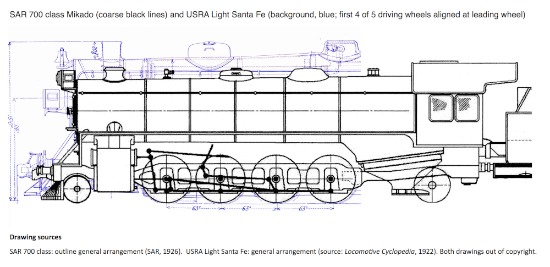
The foreground image in this diagram is a general outline of the 700 class (source: South Australian Railways, 1926). In the background is part of a general arrangement diagram of the USRA Light Santa Fe locomotive (from Locomotive Cyclopedia of American Practice, 1922; public domain). The spacing and diameter of the wheels on the two types are almost identical, except that the US locomotive is a 2-10-2.

General arrangement of SAR locomotive 702. © Copyright Hugh S. Williams 2001, CC BY-SA 3.0 AU.
The text and images in this article are licensed under the Creative Commons Attribution-Non-Commercial-Share Alike 2.5 Australia licence.
